A good bassoon reed will make playing the bassoon fun and rewarding while trying to play on a reed that isn’t working is frustrating. It is important to find a reliable source of good reeds and keep several on hand, so you don’t get stuck having to play on a damaged or bad reed. This chapter presents a variety of sources for buying bassoon reeds, tips for choosing a good reed, and an explanation of the categories of reed strengths you will encounter when buying bassoon reeds.
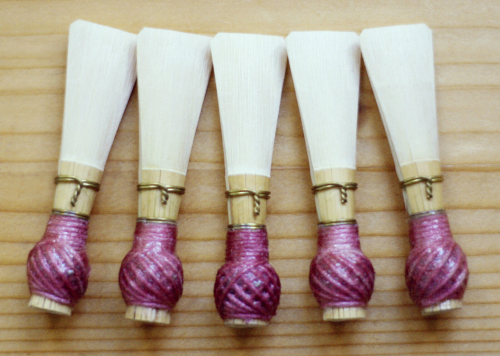
Sources for Bassoon Reeds
Professional Bassoonist
The best option is to buy reeds from a professional bassoonist who sells the reeds they make. If you live in or near a large metropolitan area, you can probably find a local bassoonist who makes and sells their reeds or knows someone who does. Make friends with bassoon players everywhere you go so that you can either buy reeds from them or get their recommendations for current brands of reeds to use and which to avoid.
There are many excellent professional reed makers who sell their reeds online through personal websites and through Etsy. I have my Bassoon Techniques students buy reeds from Bel Canto Reeds 2.0. They sell excellent reeds for beginner to intermediate students. Some advanced students like these reeds but others find them too soft.
Double Reed Supply Shop
This is the next best option. Music stores that cater specifically to double reed musicians sell reeds that have been handmade by their team of bassoonists. These double reed supply stores primarily operate online so you’ll need to determine when you are likely to need reeds and order them four to five weeks before you need them. The major benefit is that these reeds are made by professional bassoonists who know the difference between a good reed and a bad reed, and they stake their livelihood on the quality of the reeds they sell.
Three double reed stores I recommend are:
Miller Marketing Co. | Double Reed Instruments & Supplies in Wayne, PA
Forrests Music is a wind instrument sales and repair shop situated in Berkeley, California. Their primary focus is on double reed instruments, reed making supplies, music, accessories and gifts.
Bocal Majority Store Homepage – Bocal Majority Woodwinds in Richardson, TX
Bocal Majority’s store rents and sells double reed instruments, and their website includes information on financing for these instruments. They also carry reeds and some basic supplies for the double reed musician.
Local Music Store
Your local music store can be a good option, especially if you can get them to stock reeds from your preferred reed maker or brand of reed. The advantage of buying reeds in person is that you can see the reeds before you buy them.
You will not be allowed to play the reed before purchase, but a visual inspection can be helpful in choosing reeds that will play.
Online General Music Stores
Online music stores that sell a wide variety of music-related supplies (think Music & Arts, Sam Ash Music, Musicians Friend, Sweetwater, Guitar Center) and even major online stores like Amazon and Walmart generally carry commercially produced bassoon reeds. These stores purchase reeds in bulk and no one checks the quality of the reeds they purchase and sell. The price per reed is generally lower with this option but that is mitigated by the fact that not all reeds will work, and the reeds can be very inconsistent. You might get lucky with some, but you might not. If you must use this option, I suggest buying a couple of different strengths in a couple of different brands to start. Keep trying new brands and strengths until you find something you like.
Visual Properties of a Good Reed
- Check the reed blade for chips or cracks. Avoid buying a reed with a chipped or cracked blade and throw away any cracked reeds in your case.
- Make sure the tube opening (the part that will go on the bocal) is completely round and the tube wall has no gaps or thin spots.
- Choose a reed with a symmetrical tip opening. It will be more consistent across registers and dynamics.
- Check the sides of the two blades to make sure they line up. If the side of one blade sticks out beyond the other blade the reed will probably leak.
- Make sure the string wrapping or other binding (heat shrink tubing, hot glue, wax) is snug. The reed will leak probably leak and the blades can slip if the binding is loose.
- The grain of the cane should be smooth and there should be no splinters of cane in the tube or along the sides of the blades.
Note: Many handmade reeds will have the corners of the tip clipped at an angle. This makes the corners of the tip less likely to split or tear. These reeds are not damaged.
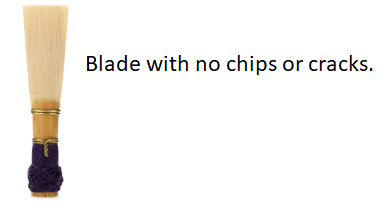
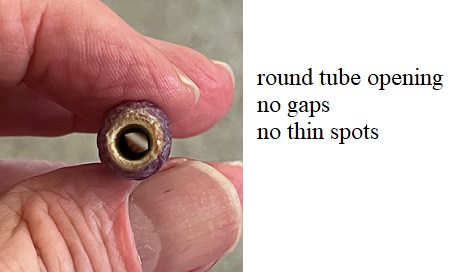

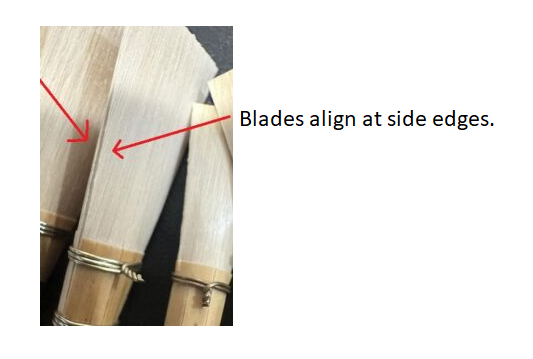
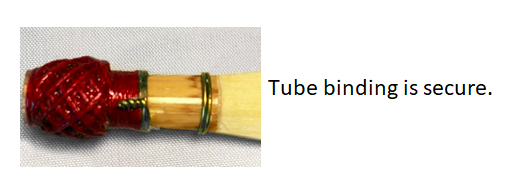
Reed Strength
Commercial reeds are sold according to their level of strength or hardness. Reed strength is a measure of the resistance you have to blow against, and how much lip pressure the reed requires to play. The commercial industry has influenced some bassoonists to add a strength designation to the reeds they sell; others sell their reeds without a strength designation.
There are five categories of reed strength. However, there is no industry standard for these categories.
- Soft (very easy to blow but will close up with any more than light embouchure pressure).
- Medium Soft (easy to blow, will close up with moderate embouchure pressure).
- Medium (requires more air and embouchure, closes with strong embouchure).
- Medium Hard (requires good breath support, moderate embouchure pressure, and firm articulation).
- Hard (requires strong breath support, strong embouchure pressure, and firm articulation).
I do not recommend buying reeds in the soft or hard categories until you have tried reeds in the middle categories. Start with a medium reed and a medium hard reed and see which gives you the best response, intonation, and tone quality.
- When starting on bassoon with no previous wind instrument experience I suggest starting on a medium reed.
- When transferring from another instrument, especially from clarinet or saxophone, I recommend starting on a medium hard reed.
- If you’ve been playing bassoon for a while and want to try another brand of reed, I suggest trying a medium-hard reed in the new brand.
You might need to move up a category as the muscles of your face and core (embouchure and breath support) develop. If the reed makes your embouchure tired quickly (after only 5-10 minutes of playing) you can either adjust the reed or try a softer reed.
Synthetic and Plastic Reeds:
Jones, Emerald, Chartier, Opus One, and other music companies sell relatively inexpensive plastic reeds. However, the tone quality created with these plastic reeds is not desirable and they can be hard to control. The best, and likely only use for these reeds is for young beginning students who might not be ready to handle a reed properly. I do not suggest plastic reeds as an alternative to cane reeds, but only as a possible first step until the students have enough control and awareness when handling the instrument and reed to avoid constantly having to replace their reeds due to damage/breakage.

Feedback/Errata